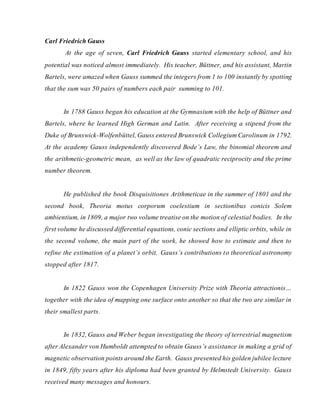
Carl friedrich gauss
- 1. Carl Friedrich Gauss At the age of seven, Carl Friedrich Gauss started elementary school, and his potential was noticed almost immediately. His teacher, Büttner, and his assistant, Martin Bartels, were amazed when Gauss summed the integers from 1 to 100 instantly by spotting that the sum was 50 pairs of numbers each pair summing to 101. In 1788 Gauss began his education at the Gymnasium with the help of Büttner and Bartels, where he learned High German and Latin. After receiving a stipend from the Duke of Brunswick-Wolfenbüttel, Gauss entered Brunswick Collegium Carolinum in 1792. At the academy Gauss independently discovered Bode’s Law, the binomial theorem and the arithmetic-geometric mean, as well as the law of quadratic reciprocity and the prime number theorem. He published the book Disquisitiones Arithmeticae in the summer of 1801 and the second book, Theoria motus corporum coelestium in sectionibus conicis Solem ambientium, in 1809, a major two volume treatise on the motion of celestial bodies. In the first volume he discussed differential equations, conic sections and elliptic orbits, while in the second volume, the main part of the work, he showed how to estimate and then to refine the estimation of a planet’s orbit. Gauss’s contributions to theoretical astronomy stopped after 1817. In 1822 Gauss won the Copenhagen University Prize with Theoria attractionis… together with the idea of mapping one surface onto another so that the two are similar in their smallest parts. In 1832, Gauss and Weber began investigating the theory of terrestrial magnetism after Alexander von Humboldt attempted to obtain Gauss’s assistance in making a grid of magnetic observation points around the Earth. Gauss presented his golden jubilee lecture in 1849, fifty years after his diploma had been granted by Helmstedt University. Gauss received many messages and honours.
- 2. His health deteriorated slowly, and Gauss died in his sleep early in the morning of 23 February, 1855.